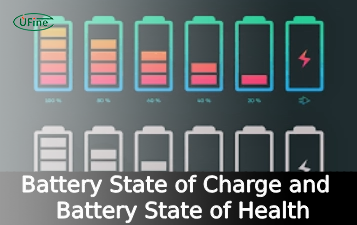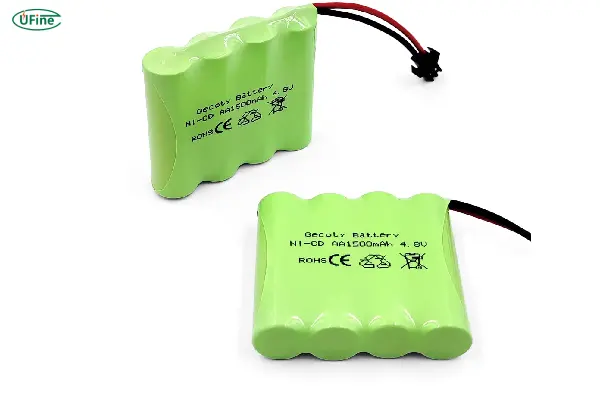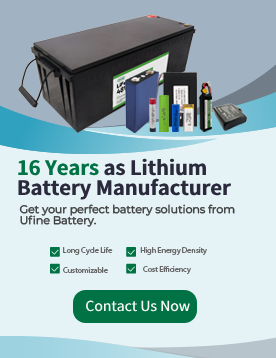
- Part 1. What is a 4.8V battery?
- Part 2. Types of 4.8V batteries
- Part 3. Common uses of 4.8V batteries
- Part 4. 4.8V battery vs. similar voltages
- Part 5. Advantages and disadvantages of 4.8V batteries
- Part 6. Key features to look for in a good 4.8V battery
- Part 7. How to charge a 4.8V battery safely
- Part 8. Final thoughts
- Part 8. FAQs
The world of batteries can be surprisingly complex. But understanding the specifics—like what a 4.8V battery is, how it works, and how it fits into your application—is key to better product performance, safety, and innovation. If you’re an engineer developing compact electronics, a hobbyist upgrading your RC models, or a business sourcing reliable energy solutions, this guide offers a comprehensive deep dive into 4.8V battery technology.
Part 1. What is a 4.8V battery?
A 4.8V battery is typically a battery pack consisting of four individual 1.2V cells connected in series. This gives a total nominal voltage of 4.8 volts. These cells can be based on various chemistries, including:
- Nickel-Metal Hydride (NiMH)
- Nickel-Cadmium (NiCd)
- Custom lithium-ion packs (though less common due to standard lithium cell voltages)
The 4.8V voltage is considered ideal for a broad range of medium-power electronics. It strikes a balance between safety, efficiency, and portability.
It’s not just the voltage that defines a battery, but the chemistry, capacity, discharge rate, internal resistance, and application that matter just as much.
Part 2. Types of 4.8V batteries
A. NiMH (Nickel-Metal Hydride)
NiMH is the most common choice for modern 4.8V battery packs. Why?
- Higher energy density than NiCd
- Environmentally safer (no cadmium)
- No memory effect under normal usage
- Supports 300–500 full charge-discharge cycles
B. NiCd (Nickel-Cadmium)
Though older, NiCd still holds a place in specific use cases:
- Tolerates extreme temperatures well
- Offers a higher discharge rate, suitable for motors
- But comes with a memory effect and toxic waste concerns
C. Custom Lithium-Ion 4.8V Packs
Most lithium-ion batteries have nominal voltages of 3.7V per cell, so a 4.8V lithium pack is often custom-made using regulated BMS and parallel/series configurations. These are:
- Lightweight
- Space-saving
- Great for advanced electronics or wearable devices
NiMH Battery vs Li-Ion Battery vs NiCad Battery: How are they different?
D. Physical Formats
- Flat Pack: Ideal for thin devices
- Stick Pack: Used in RC toys and hand tools
- Cylindrical Pack: Preferred in retrofitting and DIY applications
When off-the-shelf options don’t fit, manufacturers like Ufine Battery can custom-engineer 4.8V batteries in varied shapes, sizes, and specifications, including high-rate, ultra-thin, or high-temperature models.
Looking for tailored solutions? Contact Ufine Battery for custom 4.8V lithium battery design.
Part 3. Common uses of 4.8V batteries
You’ll find 4.8V batteries powering a wide range of devices, including:
- RC cars, helicopters, boats (thanks to high discharge needs)
- Cordless phones and walkie-talkies
- Electric toothbrushes and shavers
- Medical devices (low-power diagnostic or monitoring equipment)
- Solar-powered lighting systems
- Robotic kits and Arduino projects
The key to its popularity is the voltage—it’s just high enough to power motors and low enough to keep designs compact and safe.
Part 4. 4.8V battery vs. similar voltages
4.8V vs. 3.7V
- 3.7V is standard for single-cell Li-ion or LiPo
- 4.8V allows for more power output—useful when driving motors or LEDs
4.8V vs. 6V
- 6V systems are stronger but may damage circuits designed for 4.8V
- More battery cells = larger physical size
- 4.8V is more compact, safer for precision electronics
When choosing between voltages, always match device voltage requirements to avoid underperformance or permanent damage.
Part 5. Advantages and disadvantages of 4.8V batteries
Advantages:
- Balanced voltage ideal for moderate-power applications
- Available in rechargeable and disposable formats
- Wide compatibility with consumer electronics
- Customizable packs available
- Long cycle life for NiMH types
Disadvantages:
- NiCd packs are toxic and outdated
- Voltage drop under heavy load if capacity is too low
- Not ideal for high-voltage applications
- Charger compatibility must be ensured
Part 6. Key features to look for in a good 4.8V battery
When selecting a 4.8V battery, consider these critical specifications:
- Battery Chemistry: NiMH is preferred for reliability and safety. Lithium-based if weight and compactness are critical.
- Capacity (mAh): Choose based on application. High-drain devices need 1500mAh+, while sensors or lights may use 600–1000mAh.
- Discharge Rate (C-rating): Defines how quickly the battery can deliver current. For RC devices, a high C-rate (10C or more) is vital.
- Operating Temperature Range: Some applications (outdoors, industrial) demand resistance to temperature extremes.
- Cycle Life: A battery should support at least 300 cycles. Ufine Battery offers options with 500+ cycles for commercial use.
- Physical Size: The pack must fit your device. Check LxWxH and shape.
- Connector Compatibility: Ensure the connector matches your product (e.g., JST, Molex, Tamiya).
Tip: Always choose high-quality batteries from certified manufacturers like Ufine Battery, known for strict quality control and custom engineering.
Part 7. How to charge a 4.8V battery safely
Charging a 4.8V battery safely protects both the battery and the user. Here’s how:
Use the Correct Charger
- NiMH chargers for NiMH batteries only
- NiCd chargers for NiCd only
- Never use a lithium charger on NiMH/NiCd
Observe Charging Voltage
- Standard charge voltage for 4.8V is 5.6V–6.0V
- Avoid overvoltage to prevent swelling or leakage
Monitor Charging Time
- Smart chargers stop automatically. Manual ones must be timed.
- Charging typically takes 2–6 hours depending on capacity
Prevent Overheating
- Don’t charge in enclosed or hot environments
- Always allow batteries to cool after use before charging
Storage After Charging
- Store in cool, dry places
- Partial charge (50%) is best for long-term storage
Ufine Battery also provides matching charging solutions with overcharge and thermal protection circuits.
Part 8. Final thoughts
The 4.8V battery remains a versatile and reliable solution for electronics, toys, DIY systems, and commercial devices. Its voltage range is safe, efficient, and suitable for medium-powered tasks.
But remember: not all 4.8V batteries are the same. You must choose the right chemistry, size, capacity, and discharge rate. And when custom solutions are needed, working with a proven manufacturer makes all the difference.
Ufine Battery, a well-known Chinese lithium battery supplier, specializes in custom 4.8V batteries of all shapes and specifications. Whether you need thin, flexible lithium packs or robust NiMH for industrial tools, Ufine ensures performance, safety, and full certification support.
Part 8. FAQs
Can I use a 5V battery instead of 4.8V?
No. Even a 0.2V difference can cause damage or overheating if the device isn’t rated for it.
How many times can I recharge a 4.8V battery?
NiMH typically lasts 300–500 cycles. Quality varies by brand.
Are 4.8V batteries safe for kids’ toys?
Yes, especially NiMH versions. Just make sure the casing is sealed and durable.
Why does my 4.8V battery lose charge quickly?
It could be aging, overheating during charge, or a poor-quality pack. Time to replace.
Can Ufine Battery customize 4.8V packs for my project?
Yes. Ufine offers full custom services including shape, voltage, connectors, and BMS.
Related Tags:
More Articles

Battery State of Charge and Battery State of Health
Battery SoC vs. SoH explained: Learn professional methods to measure charge levels, test health status, and optimize battery performance for longer lifespan.
Difference Between 18650, 26650, and 21700 Batteries
What’s the difference between 18650, 21700, and 26650 batteries? Compare size, capacity, and performance to find the best lithium battery for your device.
LFP Battery Vs. LTO Battery: A Detailed Comparison
Compare LFP (LiFePO4) and LTO (Lithium Titanate) batteries by energy density, lifespan, safety, cost, and uses in EVs, solar storage, and backup power.
Compare 18650 battery types: Li-ion, LiFePO4, and LiPo. Key specs (voltage/capacity) and best uses for vapes, flashlights, EV batteries.
How to Distinguish Between Grade A, Grade B, and Grade C LiFePO4 cells?
Explore the differences between Grade A, B, and C LiFePO4 cells and learn how to choose the right one for electric vehicles, solar storage, or backup power.



